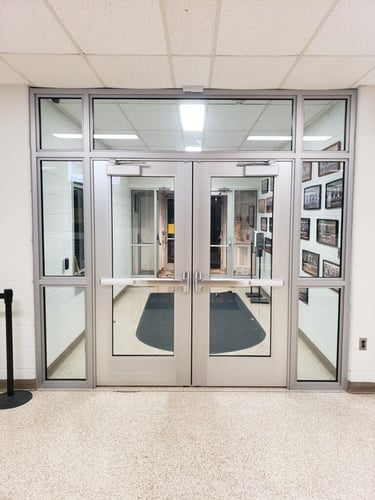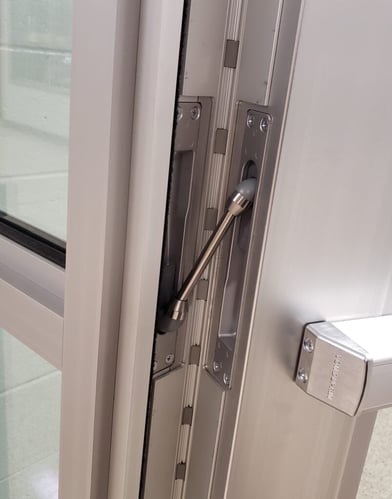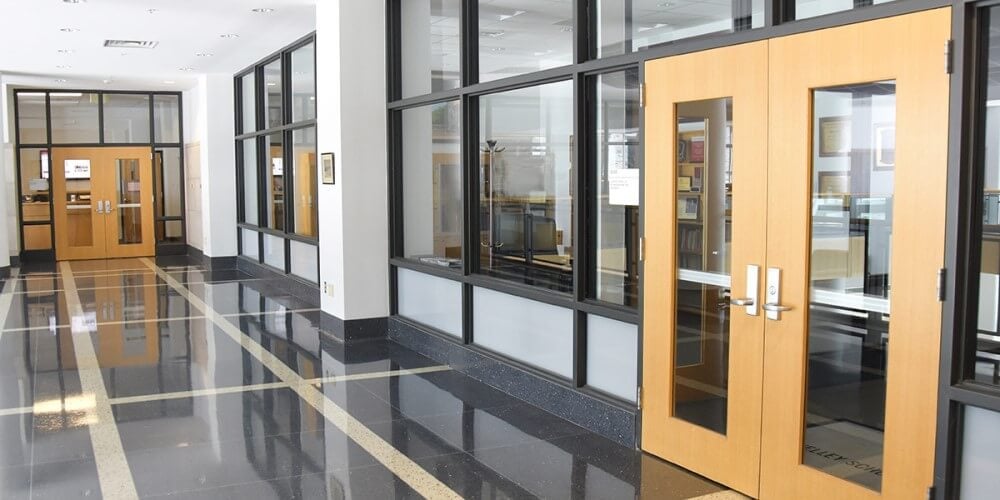School safety and security remain a growing concern for parents and children as the number of school shootings continues to increase.
The K-12 School Shooting Database reported 330 school shooting incidents, only 19 fewer than the all-time high of the previous year. (The database defines an incident as anytime a gun is fired or brandished with intent or when a bullet hits school property.)
Just a few months into the year, there have already been three school shootings that resulted in injuries or deaths, according to Education Week, noting there have been 224 such shootings since 2018.
With incidents of gun violence on the rise, creating safer environments is a high priority for school administrators.
These concerns are driving adoption of new security solutions to protect students and faculty. We've spent decades supplying bulletproof glass for schools and other vulnerable locations.
Here are five key trends we see in ballistic security barriers and bullet-resistant glass for schools.
TSS CEO Jim Richards has spent decades supplying bulletproof glass for schools and other vulnerable locations.
"I recall looking at these numbers back in 2018 and finding it sobering to see school shootings resulting in injury or death had become a weekly occurrence in the United States. But this, it's almost unimaginable to see a graph like this."
Drawing on his decades of experience, Jim sees four key trends in ballistic security barriers and bulletproof glass for schools in 2023.
1. Level 3 and Higher Bulletproof Windows for Schools
In the past, educational facilities might have chosen from a fairly wide range of lower-level ballistic glazings, standard window glass, and non-rated "security" glass. In the last several years, they've gravitated toward glass with higher levels of bullet resistance capable of stopping more shots from a wider range of firearms.
While the needs are evolving, Level 3 glass-clad polycarbonate or laminated polycarbonate is typical of installations at most school buildings.
Both are laminated materials built on a polycarbonate base with additional layers of tempered glass and/or acrylic. Combining these materials offers a balance between good light transmission, aesthetic flexibility, and performance and allows for many more options (such as reflective glass, one-way mirror glass, translucent or tinted interlayers, and so on).
GCP offers the further advantage of the durability of an outer layer of glass. In high-traffic areas where hundreds of students touch the glass each day, a glass-clad product will maintain its appearance longer because of the hardness of that glass outer layer.
It's important to note that while some states such as Delaware have broadened requirements for what constitutes a secure learning environment to include security window film, it should never be a substitute for bulletproof glass.
Security window film can offer forced entry protection and hold broken glass together, delaying an intruder from entering further into the school. However, it does not meet common standards of bulletproofing, including UL 752, which recognizes ten levels of bullet resistance, and ASTM F1233, which recognizes 12 classes.
2. Enhanced Doors and Exterior Storefront
We're seeing increased interest in higher security exterior doors and storefront entryways in educational institutions. This has been especially true since the Nashville school shooting. Widely reported security camera footage from that event demonstrated how little security a locked commercial glass door offers when confronted with a firearm.
We're fielding more inquiries for doors and storefronts with higher levels of protection, including Levels 4 and 5 to protect against high-powered rifles.
As a practical matter, most Level 4 and 5 materials and system components implicitly offer some blast and forced-entry resistance, even if they aren't rated for such. A good Level 4 or 5 door that is both forced entry and ballistically-rated will prevent entry for an extremely long time, even after being shot.Our Level 3 steel bulletproof doors famously withstand hundreds of shots from a variety of pistols and rifles even though they are technically only rated for three shots from a .44 Magnum.
TSS's LP 1250 All-Poly—one of the most popular types of bulletproof glass for schools—has passed WMFL Level 3 testing. This verifies that the glass will remain intact even after being shot with 24 rounds from a .44 Magnum and then battered for 60 minutes with a claw hammer, cold chisel, sledgehammer, iron pipes, rebar, and a fire extinguisher, then burned with a propane torch.
Schools are also increasingly interested in Level 4 and 5 GCP exterior windows, which provide similar benefits to interior GCP. Along with protection from any handgun and the vast majority of high-powered rifles, they're more resistant to attempts at vandalism and burglary and more durable against the elements.
3. Secure Vestibules
A decade ago, TSS pioneered a new approach to school security: the secure vestibule.
Limiting building access to that one centralized point and then making sure that point of access will slow or stop an attacker has proven to be so important, especially in recent years.
Now security is pushing further past the vestibule.
For example, most large modern or renovated school buildings already use interior floor-to-ceiling glass-partition walls and interior double doors at the ends of hallways. These allow greater flexibility in how the space is used and make the interior environment more efficient in terms of heating, ventilation and natural light. These partitions also play an important safety role by preventing the spread of fire.

In addition to securing their vestibule, schools are installing interior curtain walls and storefront dividers within facilities. The partition walls are already there; they're part of how that building functions. These walls are being retrofitted to be bullet resistant so that there are multiple stop points throughout the school. From a security standpoint, they're really embracing the same sort of compartmentalization they already do for fire safety.
Schools have likewise increasingly replaced some interior doors in central locations (like meeting rooms or offices) with more robust bullet-resistant doors crafted to match existing doors throughout buildings. These can serve as panic rooms in case of emergency.
4. Custom Solutions
There is no standard school layout; every building meets the unique needs of a unique community, evolving alongside that community over many years. As a result, there is no one-size-fits-all solution when it comes to bulletproof glass solutions for schools.
At TSS, our clients benefit from our decades of experience in ballistic security and deep institutional knowledge working with ballistic materials and creating custom systems that provide enduring security without creating headaches and hassles.
For example, most bulletproofing companies will wire access control systems through the door frame, a relatively easy approach. But if you want electric panic bar double doors (which are much better for high-traffic buildings like schools), you need to be able to route power through the door itself. This requires something more advanced like this through-hinge electric power transfer.
We do this more frequently because running power through the door rather than the jamb is the better solution and because we have the people and expertise to deliver it.

5. A Systems Approach to School Security
Regardless of what any given parent, politician, or vendor claims, no single security improvement can or will provide complete protection on its own. True school safety requires a systems approach—an interconnected strategy that considers the full spectrum of risk, response, and resilience.
We work with schools every day that want to improve security without making their spaces feel like prisons. Our biggest advice? Don’t start with the product. Start with the plan.
Before selecting materials or modifying your facility, ask the bigger questions:
- What threats are you most concerned about?
- What response protocols are already in place?
- How do students, staff, and visitors move through your building daily?
- Where are your current vulnerabilities and strengths?
A systems approach means thinking holistically. Physical barriers are critical, but they’re just one piece of a larger security puzzle that includes:
- Awareness: Identify entry points, blind spots, and high-risk areas with a professional threat assessment.
- Access Control: Secure vestibules, door-locking systems, and ID badge protocols help you manage who enters and moves through your school.
- Training and Drills: Even the best security barriers only work if staff and students know how to respond during an incident.
- Layered Physical Protection: Bullet-resistant glass, doors, and partition walls slow attackers and buy time for lockdown and law enforcement intervention.
Security isn’t just about stopping bullets. It’s about creating time and space for safety. The most effective schools we work with are the ones that use this layered strategy—combining smart design with practical procedures to keep their students safe without sacrificing a welcoming, learning-friendly environment.
Work With Total Security Solutions
Our team is here to help you think through the entire system—from the first point of contact to the last layer of protection. Whether you’re early in your planning process or ready to begin installation, we’ll help you take a strategic, step-by-step approach to school safety.
Learn more about gun violence trends and how to plan a secure environment in our latest resource. And when you're ready to plan your next project, contact us to discuss your options.

